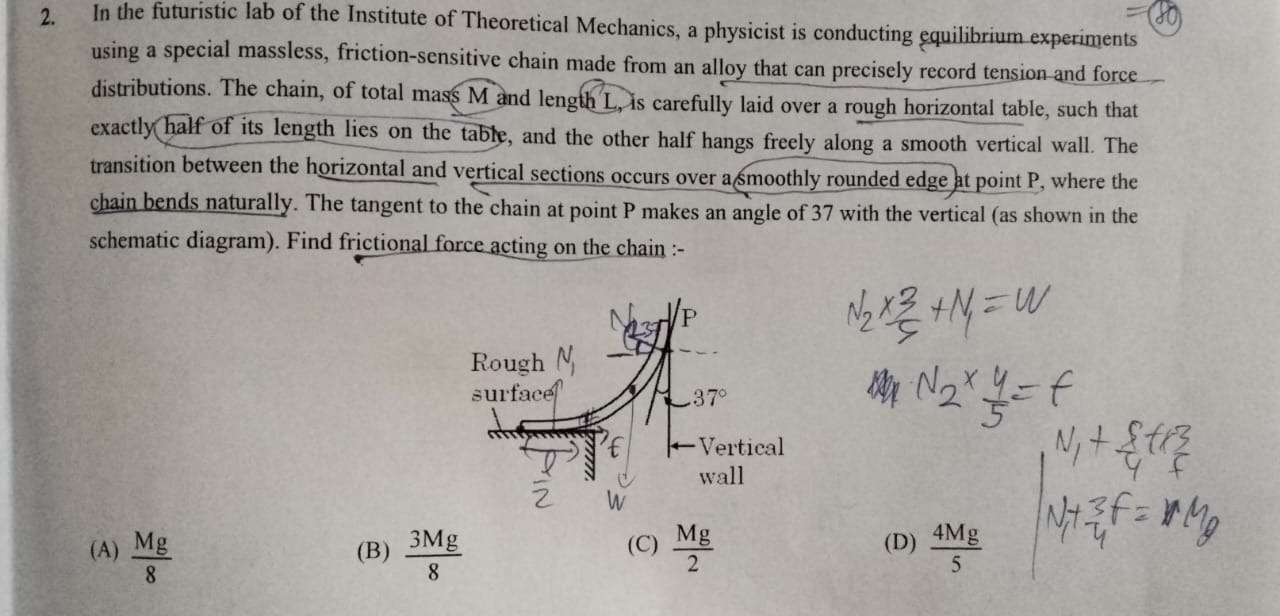Question
Question: In the futuristic lab of the Institute of Theoretical Mechanics, a physicist is conducting equilibri...
In the futuristic lab of the Institute of Theoretical Mechanics, a physicist is conducting equilibrium experiments using a special massless, friction-sensitive chain made from an alloy that can precisely record tension and force distributions. The chain, of total mass M and length L, is carefully laid over a rough horizontal table, such that exactly half of its length lies on the table, and the other half hangs freely along a smooth vertical wall. The transition between the horizontal and vertical sections occurs over a smoothly rounded edge at point P, where the chain bends naturally. The tangent to the chain at point P makes an angle of 37 with the vertical (as shown in the schematic diagram). Find frictional force acting on the chain :-
N2×53+N1=W
N2×54=f
N1+48f
N1+43f=2Mg

8Mg
83Mg
2Mg
54Mg
83Mg
Solution
The problem involves a chain of total mass M and length L, with half its length on a rough horizontal table and the other half hanging along a smooth vertical wall. The chain bends at point P, where the tangent makes an angle of 37° with the vertical. We need to find the frictional force acting on the chain.
Let's divide the chain into two parts:
- The horizontal part: Length L/2, Mass M/2.
- The hanging part (including the curved section): Length L/2, Mass M/2.
Let T be the tension in the chain at point P. The tangent to the chain at P makes an angle of 37° with the vertical.
1. Analyze the Hanging Part (Mass M/2): The hanging part is in equilibrium. The forces acting on it are:
- Its weight, (M/2)g, acting vertically downwards.
- The normal force, N2, from the smooth vertical wall, acting horizontally away from the wall (to the right in the diagram).
- The tension, T, from the chain segment connected at P. This tension acts along the tangent at P, upwards and to the left, pulling the hanging part.
Let's resolve the tension T into its components:
- Vertical component: Tcos(37∘) (upwards)
- Horizontal component: Tsin(37∘) (to the left)
Applying equilibrium conditions for the hanging part:
-
Vertical Equilibrium: Sum of upward forces = Sum of downward forces Tcos(37∘)=(M/2)g Using cos(37∘)=4/5: T×(4/5)=(M/2)g T=45×2Mg=85Mg
-
Horizontal Equilibrium: Sum of forces to the right = Sum of forces to the left N2=Tsin(37∘) Using sin(37∘)=3/5: N2=85Mg×53=83Mg
2. Analyze the Horizontal Part (Mass M/2): The horizontal part is also in equilibrium. The forces acting on it are:
- Its weight, (M/2)g, acting vertically downwards.
- The normal force, N1, from the rough horizontal table, acting vertically upwards.
- The frictional force, f, from the rough horizontal table, acting horizontally to the left (opposing the tendency of the chain to slide to the right).
- The tension, T, from the curved part at P. This tension acts on the horizontal part towards P, meaning downwards and to the right, pulling the horizontal part.
Let's resolve the tension T into its components:
- Vertical component: Tcos(37∘) (downwards)
- Horizontal component: Tsin(37∘) (to the right)
Applying equilibrium conditions for the horizontal part:
-
Vertical Equilibrium: Sum of upward forces = Sum of downward forces N1=(M/2)g+Tcos(37∘) N1=(M/2)g+85Mg×54 N1=(M/2)g+84Mg=(M/2)g+(M/2)g=Mg
-
Horizontal Equilibrium: Sum of forces to the right = Sum of forces to the left Tsin(37∘)=f f=85Mg×53 f=83Mg
Thus, the frictional force acting on the chain is 83Mg.
3. Consistency Check (Entire Chain): Consider the entire chain as a system.
- Horizontal Forces: The only external horizontal forces are the normal force N2 from the vertical wall (to the right) and the frictional force f from the horizontal table (to the left). For equilibrium, these must balance: N2=f From our calculations, N2=83Mg and f=83Mg, which is consistent.
The final answer is 83Mg.
